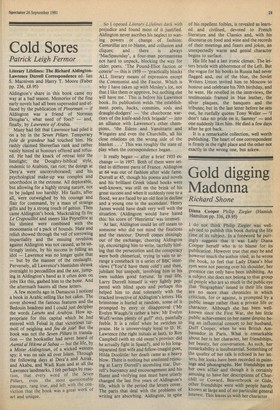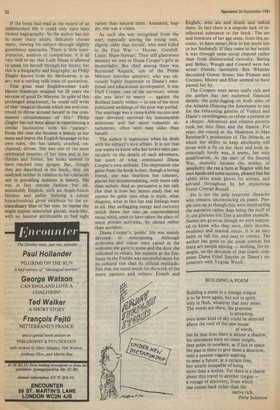Gold digging Madonna
Richard Shone Diana Cooper Philip Ziegler (Hamish Hamilton pp. 336, £9.95) I do not think Philip Ziegler was welladvised to publish this book during the life time of its subject. In a foreword he purringly suggests that it was Lady Diana Cooper herself who is to blame for its publication. However true that may be and however much the author tried, as he wrote the book, to feel that Lady Diana's blue eyes were not peering over his shoulder, her presence can only have been inhibiting. As a subject she does not belong to that group of people who are so much in the public eye that 'biographies' issued in their life time are no more than chronicles in which criticism, for or against, is prompted by a public image rather than a private life or character. Although she has been wellknown since the First War, she has little public achievement to her name despite being an influential consort to her husband, Duff Cooper, when he was British Ambassador in Paris. What is remarkable about her is her character, her friendships, her beauty, her conversation. As such, her remarkability is insubstantial. Something of the quality of her talk is echoed in her letters; her looks have been recorded in paintings and photographs. Her friendships are her own affair and though it is certainly amusing to have her descriptions of Churchill or Coward, Beaverbrook or Gide, other friendships were with people hardly known at large and of no particular general interest. This leaves us with her character. If the book had read as the record of an unblemished life it could only have been violent hagiography. So the author has put in some sharp asides, delicately chosen warts, viewing his subject through slightly governessy spectacles. There is little interpretation, analysis or comparison. It is all very well to say that Lady Diana is allowed to speak for herself through her letters; but this is a biography and biography, as Philip Ziegler knows from his Melbourne, is an art, not a rattling milk-train of quotations.
That great mad Englishwoman Lady Hester Stanhope retained for 28 years the services of good Dr Meryon. In spite of this prolonged attachment, he could still write of that 'magical illusion which she ever contrived to throw around herself in the commonest circumstances of life.' Philip Ziegler has not been alone in experiencing a similar fascination with his 'patient'. From the time she became a beauty in her teens and learnt the English language to her own rules, she has tamed, crushed, enchanted, driven. She was one of the most celebrated beauties of her time and in her thirties and forties, her looks seemed to have reached their apogee. But, though they are described in the book, they are analysed neither in relation to her character nor to prevailing fashions in beauty. She was in fact outside fashion but unmistakably English, with an Anglo-Saxon fairness and pallor (belying a robust hypochondria) given emphasis by the extraordinary blue of her eyes. In repose she might appear somewhat glacial, mask-like, with an hauteur attributable to bad sight
rather than natural mien. Animated, happy, she was a vision.
As such she was recognised from the start, especially among the young men, slightly older than herself, who were killed in the First War — Horner, Grenfell, Lister, Shaw-Stewart. Their still glamorous memory we owe to Diana Cooper's gifts as memorialist. But chief among them was Raymond Asquith, son of the Prime Minister (another admirer), who was obviously highly important to Diana's emotional and educational development. It was Duff Cooper, one of the survivors, whom she was later to marry — against the Rutland family wishes — in one of the most publicised weddings of the post-war period. The marriage was a remarkable success and their devotion survived his innumerable mistresses and her more romantic attachments, often with men older than herself.
The author is ingenuous when he deals with his subject's love affairs. It is not that one wants to know who her lovers were particularly or the details of each adventure, but more of what constituted Diana Cooper's own attitude. The impression one gains from the book is that, though a loving friend, she was heartless but tolerant, glacial but accommodating, with more talk than action. And so persuasive is her talk (for that is how her letters read) that we cannot be quite sure what is truth, what disguise, what in fact her real feelings were at all. Her unflagging energy and curiosity which threw her into an unprecedented social whirl, seem to have taken the place of more private activities, by choice rather than accident.
Diana Cooper's 'public' life was mainly devoted to entertaining. Although eyebrows and voices were raised at the welcome she gave to some and the door she indicated to others, her sojourn at the Embassy in the Forties was successful more for its cultural vim than its official rectitude. Not that she cared much for the work of the many painters and writers, French and
English, who ate and drank and talked there. In fact there is a singular lack of intellectual substance to the book. The art and literature of her age seem, from this account, to have meant little to her (even less to her husband). If they came to her notice it was through some social channel rather than from disinterested curiosity. Baring and Belloc, Waugh and Coward were her writer friends; inevitably Rex Whistler decorated Gower Street; but Picasso and Cocteau, Moore and Eliot seemed to have passed her by.
The Coopers were never really rich and the author has not eschewed financial details: the gold-digging on both sides of the Atlantic (fleecing the Americans to pay for the exhausting gaieties of Venice) and Diana's unwillingness to refuse a present or a cheque. Adventure and relative poverty took her into films and the theatre. For years she toured as the Madonna in Max Reinhardt's production of The Miracle, in which her ability to keep absolutely still (even with a fly on her face) and look increasingly lovely was, it seems, her only qualification. At the start of the Second War, necessity became the mother of simplicity; she ran a farm at Bognor with her own hands and some success, pleased that her rabbit skins made gloves for airmen, and advised throughout by her mysterious friend Conrad Russell.
He is not the only recurrent character who remains unconvincing on paper. People turn up as though they were interrupting the narrative rather than being the stuff of it; the glorious Iris Tree is another example. Names are given as though we were supposed to know who they were, their income, residence and marital status. It is an easy habit to fall for, and easy to correct. The author has gone to the usual sources but there are people missing — nothing, for example, on the devotion of that titanic composer Dame Ethel Smythe or Diana's encounters with Virgina Woolf.



































 Previous page
Previous page